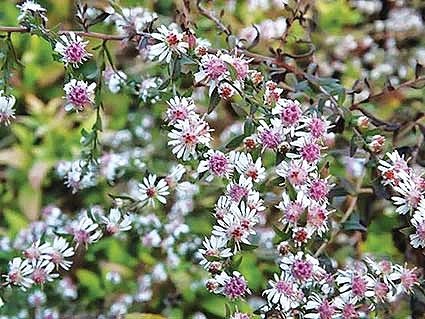
Gardening Journal: Plant of The Month – Aster Lady In Black
October signals the approach of the winter, a time of low light and fading foliage. There is still much to see and do, so it’s not quite time to hang up the tools and forget about the garden just yet. Make the most of the better weather and get out while the sun is still shining.Some may think of Asters as old fashioned, high maintenance and invasive, establishing quickly and out competing its neighbours within a couple of years of planting. However, not all Asters behave in this way and there are some varieties that are well worth planting, providing you with colour in the border when most other flowers are long gone.
Asters have had some bad press. Their floriferous nature can make them top heavy and unable to stand up without assistance, they also tend to suffer from the disfiguring fungal disease powdery mildew. Their positives, however, far outweigh any negatives and plant breeders have done much to alleviate these problems. One of these newer selections is Aster lateriflorus ‘Lady in Black’ which has an almost shrub like rigidity and seems to be totally free from both pest and disease. It steadily grows throughout the season, minding its own business whilst all around are merrily blooming away. Then in late summer it gives a remarkable display that would bring a smile to the hardest heart. Pink centered tiny white flowers festoon the dark leaved foliage.
Aster is the namesake of the Asteraceae, better known as the daisy family. Until recently this family contained around 600 species but the botanists decided to have a bit of shake-up and have reduced the number to approximately 180. Asters are renowned for giving a new lease of life to late summer flower borders. In fact, one of their common names is Michaelmas Daisy as they are often blooming around 29th September, St Michaelmas Day.
Asters are generally native to eastern North America where it was used in the form of root tea for gastric problems. The whole plant was also used to treat wounds in the form of either a tea or a poultice. In the past it was believed that by burning the leaves, serpents would be kept at bay. Due to short nectar tubes in the flowers, it attracts a large variety of insects and is an invaluable late season food source too.
Space can be made for this late flowering perennial in the middle of the border where its purple foliage can become a backdrop to other summer flowering perennials. Try planting alongside miscanthis and pennisetum for textural contrasts and behind hardy geraniums where the strangely stems of the geranium may wander through the stems of the aster, be sure to include some rudbeckia and sedum and you will have a planting combination that will see you through the majority of the summer.
Jobs to do this month include:
Ornamental Garden:
• Mulch borders with compost if not done in the spring.
• Continue deadheading if weather is mild.
• Remove fallen leaves from Roses to prevent blackspot.
• Continue to tidy borders of weeds and leaves.
• Transplant any plants that need to be moved.
• Plant spring bulbs such as Daffodils etc. But NOT tulips – wait until November to avoid tulip blight.
• Lift and divide perennials.
• Plant up containers etc for winter bedding displays.
• Apply autumn lawn feed etc.
• Now is a good time to plant trees and shrubs – the soil is moist and warm.
• Sow sweet peas under glass.
• Can lift summer flowering bulbs / tubers and overwinter in greenhouse or can heavily mulch plants and leave in the ground, e.g. gladioli, dahlia, canna.
• Cut back herbaceous perennials as they die back.
• Prune climbing roses to avoid wind rock.
• Refill bird feeders regularly.
• Install insect hotels/log piles.
Vegetable Garden:
• Begin planting garlic.
• Apply fleece to late season crops when frost is forecast.
• Lift and divide rhubarb.
• Clear away old foliage of strawberries to prevent pest and diseases.
• Pot up herbs and take into frost free greenhouse or windowsill to continue cropping through the winter.
• Complete planting onion setts and plant out spring cabbage.
• Harvest squash and pumpkin if not already done so.

